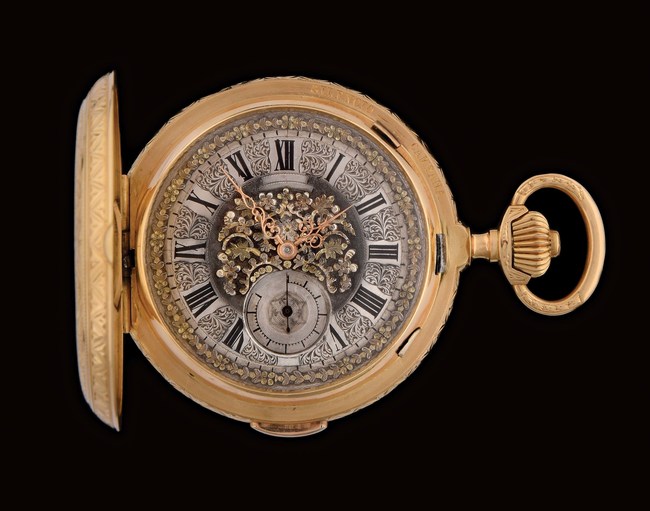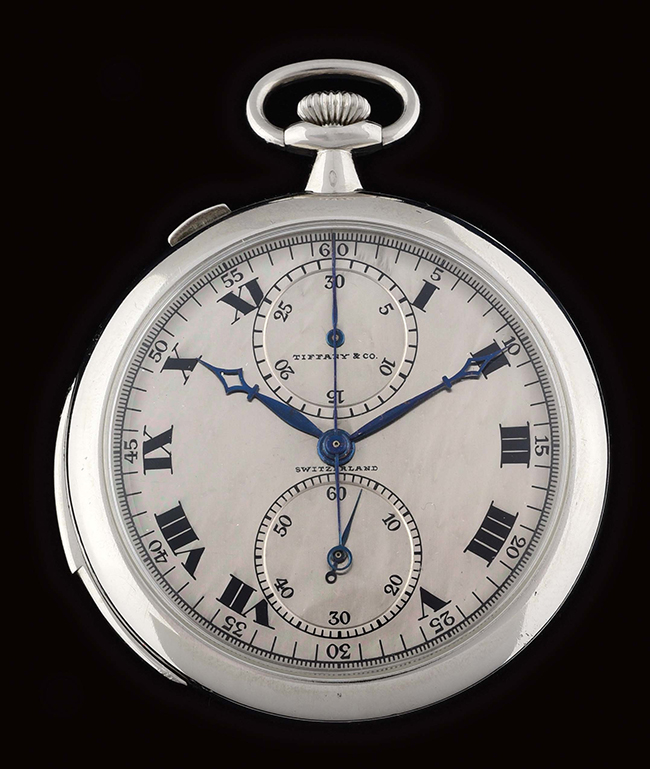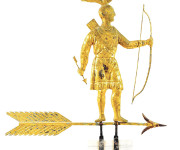Times may change, but time never does. Whether measured by the Greenwich Royal Observatory clock in England or a bedside digital alarm clock, a day is universally considered to be a 24-hour period with 60 minutes in each hour. And as Morphy’s Tuesday, June 30 auction attests, no device keeps track of the hours and minutes quite as precisely or beautifully as an antique pocket watch. Over 650 high-quality pocket watches from a single-owner collection, including more than 250 complicated examples, are entered in the no-reserve sale, each a reflection of the era in which it was created. It is believed to be one of the largest collections of gold pocket watches ever to be offered for public sale.

Fine and rare circa-1896 Swiss Grande Sonnerie “clock watch” quarter-hour repeating pocket watch in 18K gold hunter’s case decorated with a cowboy on horseback throwing a lasso (obverse) as he chases two ostriches (reverse) ©
The first pocket watch was invented in 1510 by Peter Henlein, in Nuremberg, Germany. Italians were producing clocks small enough to be worn on one’s person in the early 16th century, as well. For many centuries to follow, a clue to a gentleman’s status was the quality, intricacy and beauty of the pocket watch he carried.
“Pocket watches, whether of gold, platinum or more modest metals, have long been treasured as family heirlooms to be passed down through subsequent generations,” said Dan Morphy, founder and president of Morphy Auctions. “They also influenced men’s fashion. There was a time when every man, rich or working class, carried a pocket watch, so tailors started designing jackets and vests with special pockets to accommodate the timepieces. By discreetly opening his jacket to check the time, a watch’s owner could reveal his wealth and status to those around him.”
One of the top lots in Morphy’s June 30 auction is a rare and important Marius LeCoultre 18K pink gold hunter’s case minute repeating perpetual calendar chronograph pocket watch with moon phase and retrograde date. With a heavily hand-decorated gold case, it is signed “M. Le Coultre, Geneva,” and is hallmarked and numbered “2655.” Auction estimate: $20,000-$40,000.
A fine and rare Swiss Grande Sonnerie “clock-watch” quarter-hour repeating pocket watch in a gorgeous 18K gold hunter’s case is decorated with a cowboy on horseback throwing a lasso (obverse) as he chases two ostriches (reverse). The cuvette is marked/hand-engraved, in part: “Medaille D’or Geneve, 1896, Grande Sonnerie.” Its movement, marked with the patent number “6835” inside the Swiss Federal Cross, was possibly made by Audemars Freres, Brassus & Geneva. Estimate: $20,000-$40,000.

Extremely rare and important platinum Tiffany & Co., by Touchon & Co., Swiss minute-repeating split-second Rattapante chronograph open-face pocket watch with hallmarks that were in use from 1914-1933. Estimate: $10,000-$20,000 ©
Also estimated at $20,000-$40,000, a rare and important circa-1880 Henri Grandjean & Co., Grande Sonnerie clock-watch is presented in a hand-decorated 18K yellow gold hunter’s case with engraved birds and flowers. Its complications include a minute repeater, leap year perpetual calendar, moon phase and quarter-hour passing strike chime that can be silenced if desired. The case and movement are fully hallmarked.
A rare circa-1880 Gerome Hoff & Fils Grande Sonnerie quarter-hour repeating pocket watch is housed in a superbly engraved hunter’s case, Complications include a quarter-hour passing strike chime that can be set to Grande, Petite or silence. There is also a quarter-hour repeater function. Estimate: $15,000-$30,000.
An 18K gold Grand Sonnerie minute-repeating pocket watch made by Cooke & Kelvey, Calcutta, is housed in a hunter’s case hallmarked with the Chester City mark, an 1897 date mark and crown with “18” fineness marks. Estimate: $10,000-$20,000.






